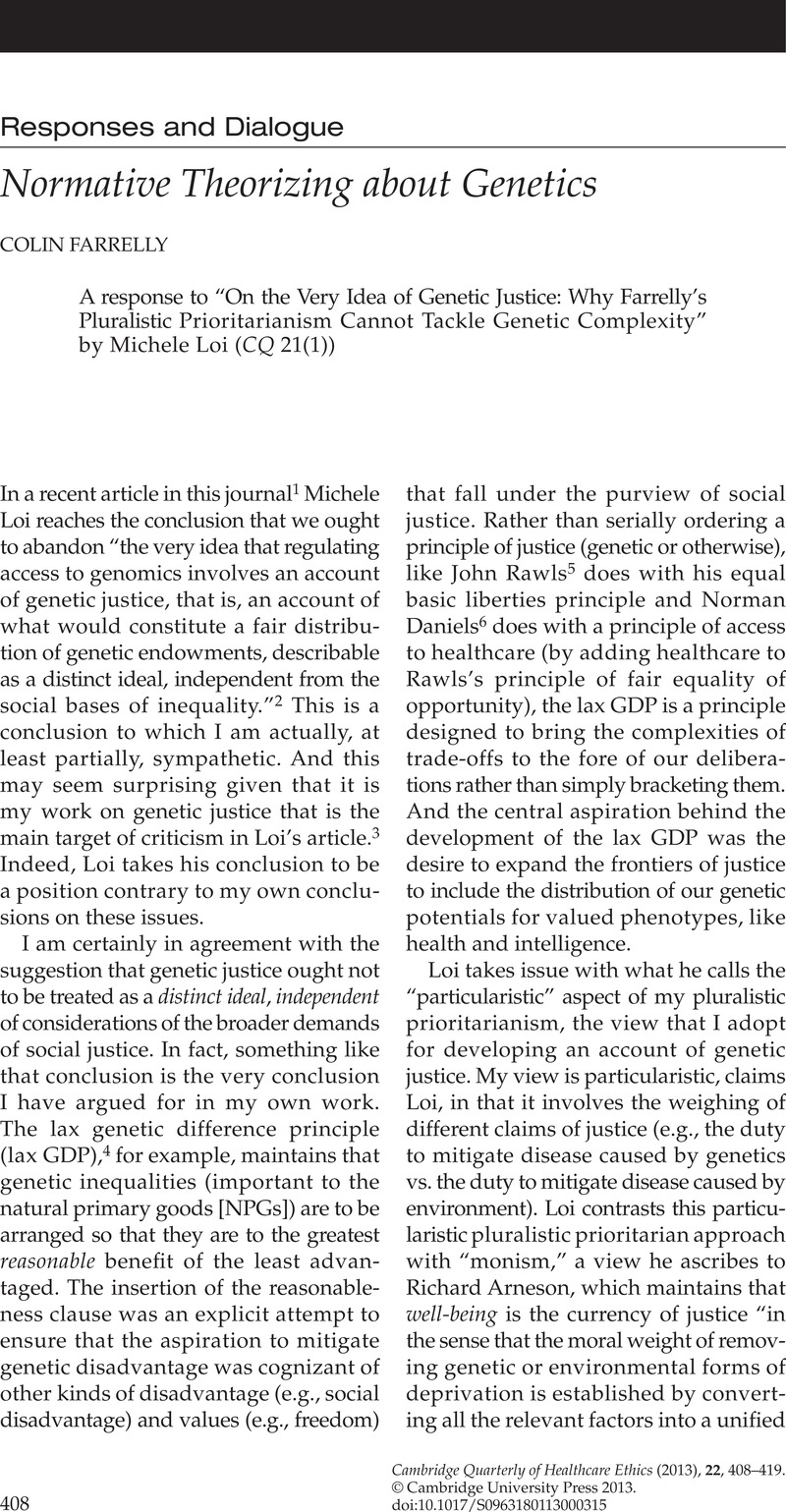Published online by Cambridge University Press: 06 August 2013

1. Loi, M. On the very idea of genetic justice: Why Farrelly’s pluralistic prioritarianism cannot tackle genetic complexity. Cambridge Quarterly of Healthcare Ethics 2012;21(1):64–77.CrossRefGoogle Scholar
2. See note 2, Loi 2012, at 75.
3. In particular Loi focuses on the following: Farrelly, C.Genes and social justice: A Rawlsian reply to Moore. Bioethics 2002;16:72–83CrossRefGoogle ScholarPubMed; Farrelly, C.The genetic difference principle. American Journal of Bioethics 2004;4:W21–W28CrossRefGoogle ScholarPubMed; Farrelly, C. Genetic justice must track genetic complexity. Cambridge Quarterly of Healthcare Ethics 2008;17(1):45–53CrossRefGoogle ScholarPubMed; and Farrelly, C. Preimplantation genetic diagnosis, reproductive freedom, and deliberative democracy. Journal of Medicine and Philosophy 2009;34(2):135–54.CrossRefGoogle ScholarPubMed
4. See note 3, Farrelly 2004.
5. Rawls, J. A Theory of Justice. Cambridge, MA: Harvard University Press; 1971.CrossRefGoogle Scholar
6. Daniels, N. Just Health Care. Cambridge: Cambridge University Press; 1985.CrossRefGoogle ScholarPubMed
7. See note 2, Loi 2012, at 69.
8. Arneson, RJ. Luck egalitarianism and prioritarianism. Ethics 2000;110(2):339–49, at 340.CrossRefGoogle Scholar
9. See, for example, Buchanan, A, Cole, T, Keohane, RO. Justice in the diffusion of innovation. Journal of Political Philosophy 2011;19(3):306–32.CrossRefGoogle Scholar
10. Perls, T, Bubrick, E, Wager, C, Vijg, J, Kruglyak, L. Siblings of centenarians live longer. The Lancet 1998;351:1560.CrossRefGoogle ScholarPubMed
11. Atzmon, G, Schechter, C, Greiner, W, Davidson, D, Rennert, G, Barzilai, N. Clinical phenotype of families with longevity. Journal of the American Geriatrics Society 2004;52:274–7.CrossRefGoogle ScholarPubMed
12. Van der Zwaluw, CS, Kuntsche, E, Engels, R. Risky alcohol use in adolescence: The role of genetics (DRD2, SLC6A4) and coping motives. Alcoholism: Clinical and Experimental Research 2011;35(4):756–64.CrossRefGoogle ScholarPubMed
13. Deary, IJ, Spinath, FM, Bates, TC. Genetics of intelligence. European Journal of Human Genetics 2006;14:690–700.CrossRefGoogle ScholarPubMed
14. Meyer-Lindenberg, A, Buckholtz, JW, Kolachana, B, Hariri, AR, Pezawas, L, Blasi, G, et al. Neural mechanisms of genetic risk for impulsivity and violence in humans. Proceedings of the National Academy of Sciences of the United States of America 2006;103(16):6269–74.CrossRefGoogle ScholarPubMed
15. Fowler, J, Dawes, C. Two genes predict voter turnout. Journal of Politics 2008;70(3):579–94CrossRefGoogle Scholar; and Fowler, J, Baker, L, Dawes, C. Genetic variation in political participation. American Political Science Review 2008;102:233–48.CrossRefGoogle Scholar
16. Young, L. Love: Neuroscience reveals all. Nature 2009;457:148.CrossRefGoogle Scholar
17. “The pursuit of science in a society is well-ordered when the research effort is efficiently directed toward the questions that are most significant”: Flory, JH, Kitcher, P. Global health and the scientific research agenda. Philosophy and Public Affairs 2004;32(1):36–65, at 59.CrossRefGoogle ScholarPubMed
18. See note 3, Farrelly 2008, at 49.
19. Sack, GH. Medical Genetics. New York: McGraw-Hill; 1999, at 149.Google Scholar
20. Cystic Fibrosis Foundation. Frequently Asked Questions; available at http://www.cff.org/AboutCF/Faqs/#What_is_the_life_expectancy_for_people_who_have_CF_%28in_the_United_States%29 (last accessed 27 July 2011).
21. Thorgeirsson, TE, et al. A variant associated with nicotine dependence, lung cancer and peripheral arterial disease. Nature 2008;452:638–42.CrossRefGoogle ScholarPubMed
22. Substance Abuse and Mental Health Services Administration. Results from the 2005 National Survey on Drug Use and Health: National Findings. Rockville, MD: Office of Applied Studies; 2006. The survey results are available online at http://oas.samhsa.gov/nsduh/2k5nsduh/2k5results.htm (last accessed 27 July 2011).
23. Kruger, DJ, Nesse, RM. Sexual selection and the male:female mortality ratio. Evolutionary Psychology 2004;2:66–85.CrossRefGoogle Scholar
24. Loi constructs a second scenario, but, because of space limitations, I limit my response to this first scenario. Much of what I say about the first example would also apply to his second scenario.
25. See, for example, Farrelly, C. Global aging, well-ordered science and prospection. Rejuvenation Research 2010;13(5):607–12CrossRefGoogle ScholarPubMed; Farrelly, C. Why aging research? Annals of the New York Academy of Sciences 2010;1197:1–8CrossRefGoogle ScholarPubMed; and Farrelly, C. Has the time come to take on time itself? British Medical Journal 2008;337:147–8.CrossRefGoogle Scholar